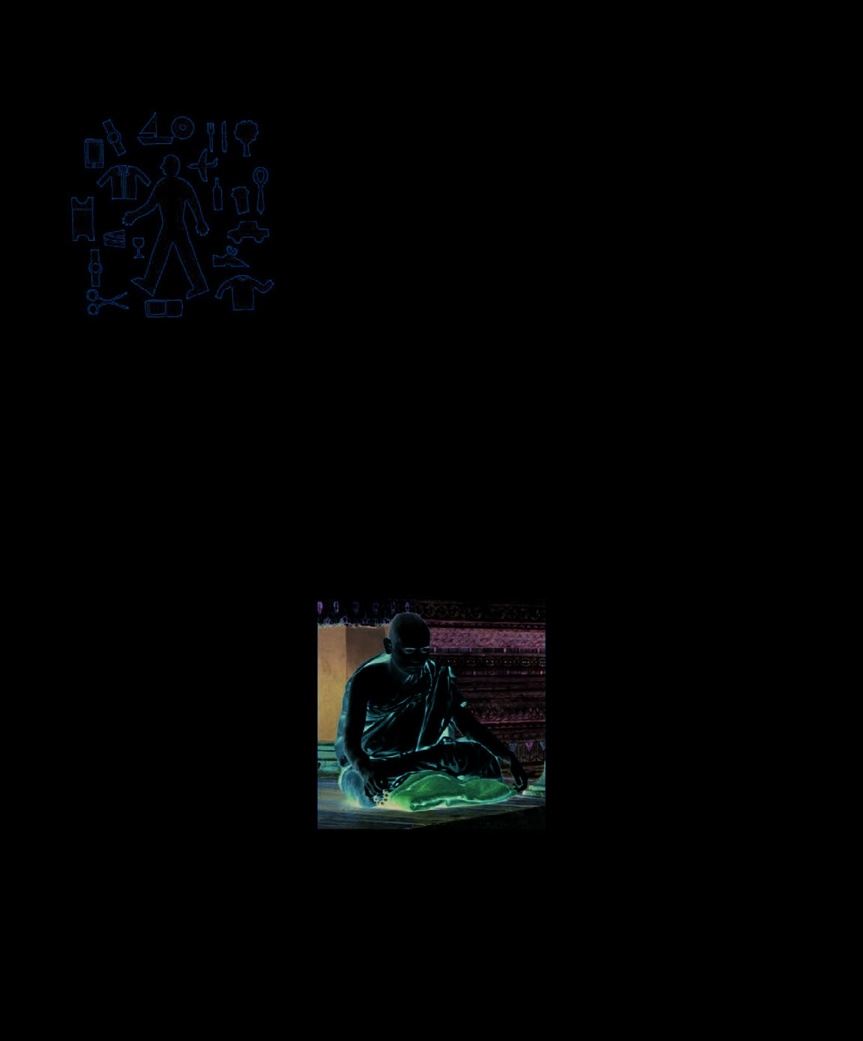The Psychology Book (65 page)
Read The Psychology Book Online
Authors: Unknown

COGNITIVE PSYCHOLOGY 207
such as a description of the mall,
disturbing dream is more vividly
were worked out in collaboration
recalled and even mistaken for
with the relatives. Interviewed
reality. It was this idea that
about these stories one week later
prompted her to say, “what we
and then again two weeks later, the
believe with all our hearts is not
participants were asked to rate how
necessarily the truth.”
In real life, as well as in
well they remembered the events in
However, in 1986, psychologists
experiments, people can
the four stories. At both interviews,
John Yuille and Judith Cutshall
come to believe things that
25% of the participants claimed to
did manage to conduct a study of
never really happened.
have some memory of the mall
memory following a traumatic
Elizabeth Loftus
incident. After the experiment,
situation. They found that witnesses
participants were debriefed and
to an actual incident of gun shooting
told that one of the stories was
had remarkably accurate memories,
false—did they know which it was?
even six months after the event, and
Of the 24 participants, 19 correctly
resisted attempts by the researchers
chose the mall as the false memory;
to distort their memories though
but five participants had grown to
misleading questions.
sincerely believe in a false memory
used to recover memory, including
of a mildly traumatic event.
Questionable therapy
psychotherapeutic techniques such
Loftus had provided an insight
Loftus points out that her findings
as regression, dream work, and
into how false memories might form
do not deny that crimes such as
hypnosis. Consequently, it raised
in real, everyday settings. For ethical
abuse may have taken place, nor can
the possibility that false memories
reasons Loftus could not devise an
she prove that repressed memories
can be implanted during the
experiment to test whether a truly
do not exist; she merely stresses the
therapeutic process by suggestion,
traumatic false memory (such as
unreliability of recovered memory,
and in the 1990s several US
child abuse) would be even more
and insists that courts must seek
patients who claimed they were
vividly recalled and sincerely
evidence beyond this. Her work
victims of “false memory syndrome”
believed, but she suggested that it
has also called into question the
successfully sued their therapists.
would, in the same way that a more
validity of the various methods
Unsurprisingly, this apparent attack
on the very idea of repressed
Despite the unreliability
of
memory earned an adverse reaction
eyewitness testimony, Loftus found
that jurors tend to give more weight
from some psychotherapists, and
to it than any other form of evidence
split opinion among psychologists
when reaching a verdict.
working in the field of memory.
Reaction from the legal world was
also divided, but after the hysteria
surrounding a series of child abuse
scandals in the 1990s had died
down, guidelines incorporating
Loftus’s theories on the reliability
of eyewitness testimony were
Do you swear to tell
adopted by many legal systems.
the truth, the whole truth,
Today, Loftus is acknowledged
or whatever it is you
as an authority on the subject of
think you remember?
false memory. Her theories have
Elizabeth Loftus
become accepted by mainstream
psychology and have inspired
further research into the fallibility
of memory in general, notably
by Steven Schacter in his book,
The Seven Sins of Memory
. ■

208
THE SEVEN SINS
OF MEMORY
DANIEL SCHACTER (1952– )
The first three Schacter calls “sins
IN CONTEXT
F
orgetting, Daniel Schacter
believes, is an essential
of omission,” or forgetting, and the
function of human memory,
last four are “sins of commission,”
APPROACH
allowing it to work efficiently. Some
or remembering. Each sin can
Memory studies
of the experiences we go through
lead to a particular type of error
BEFORE
and the information we learn may
in recollecting information.
1885
Hermann Ebbinghaus
need to be remembered, but much
The first of the sins, transience,
describes the “forgetting
is irrelevant and would take up
involves the deterioration of memory,
curve” in
Memory
.
valuable “storage space” in our
especially of episodic memory (the
memory, so is “deleted,” to use an
memory of events), over time. This
1932
Frederic Bartlett lists
analogy with computers that is
is due to two factors: we can recall
seven ways in which a story
often made in cognitive psychology.
more of a recent event than one in
may be misremembered in
Sometimes, however, the process
the distant past; and each time we
his book
Remembering
.
of selection fails. What should have
remember the event (retrieve the
1956
George Armitage Miller
been tagged as useful information
memory), it is reprocessed in the
publishes his paper
The
and stored for future use is removed
brain, altering it slightly.
from memory and therefore forgotten;
Magical Number Seven,
or—conversely—trivial or unwanted
Plus or Minus Two
.
information that should have been
1972
Endel Tulving makes the
removed is kept in our memory.
distinction between semantic
Storage is not the only area of
and episodic memory.
memory functioning with potential
problems. The process of retrieval
We don’t want a
AFTER
can cause confusion of information,
memory that is going
1995
Elizabeth Loftus studies
giving us distorted recollections.
to store every bit of every
retroactive memory in
The
Schacter lists seven ways in which
experience. We would
Formation of False Memories
.
memory can let us down: transience,
be overwhelmed with
2005
US psychologist Susan
absent-mindedness, blocking,
clutter of useless trivia.
Clancy studies apparent
misattribution, suggestibility, bias,
Daniel Schacter
memories of alien abduction.
and persistence. In a reference to
the Seven Deadly Sins, and with a
nod to George Armitage Miller’s
“magical number seven,” he calls
these the “seven sins of memory.”

COGNITIVE PSYCHOLOGY 209
See also:
Hermann Ebbinghaus 48–49 ■ Bluma Zeigarnik 162 ■ George Armitage Miller 168–73 ■ Endel Tulving 186–91 ■
Gordon H. Bower 194–95 ■ Elizabeth Loftus 202–07 ■ Frederic Bartlett 335–36
Absent-mindedness, the sin that
The Seven Sins of Memory
manifests itself in mislaid keys and
missed appointments, is not so
much an error of recollection but
of selection for storage. Sometimes
…
transience
.
we do not pay enough attention at
Sometimes we
forget
the time we do things (such as
important things
when we put down keys), so the
because of…
…
absent-mindedness
.
information is treated by the brain
as trivial and not stored for later
use. In contrast to this is the sin of
blocking, where a stored memory
…
blocking
.
cannot be retrieved, often because
another memory is getting in its
way. An example of this is the
“tip-of-the-tongue” syndrome,
And sometimes our
memories become
…
misattribution
.
where we can nearly—but not
confused
through…
quite—grasp a word from memory
that we know very well.
...
suggestibility
.
Sins of commission
The “sins of commission” are
slightly more complex, but no less
common. In misattribution, the
…
bias
.
information is recalled correctly,
And sometimes we
but the source of that information
remember things
we want
is wrongly recalled. It is similar in
to forget
through…
its effect to suggestibility, where
…
persistence
.
recollections are influenced by the
way in which they are recalled, for
example, in response to a leading
question. The sin of bias also
whose work on episodic versus
Daniel Schacter
involves the distortion of recollection:
semantic memory was causing
this is when a person’s opinions
Daniel Schacter was born in
lively debate at the time. In
and feelings at the time of recalling
New York in 1952. A high-school
1981, he established a unit for
an event color its remembrance.
course sparked his interest in
memory disorders at Toronto,
Finally, the sin of persistence is
psychology, which he went on to
with Tulving and Morris
an example of the memory working
study at the University of North
Moscovitch. Ten years later, he
too well. This is when disturbing or
Carolina. After graduation, he
became Professor of Psychology
upsetting information that has
worked for two years in
at Harvard, where he set up the
been stored in memory becomes
the perception and memory
Schacter Memory Laboratory.
intrusively and persistently recalled,
laboratory of Durham Veterans
Hospital, observing and testing
Key works
from minor embarrassments to
patients with organic memory
extremely distressing memories.
disorders. He then began
1982
Stranger Behind the
However, the sins aren’t flaws,
postgraduate studies at Toronto
Engram
Schacter insists, but the costs we
University, Canada, under the
1996
Searching for Memory
pay for a complex system that works
supervision of Endel Tulving,
2001
The Seven Sins of Memory
exceptionally well most of the time. ■
